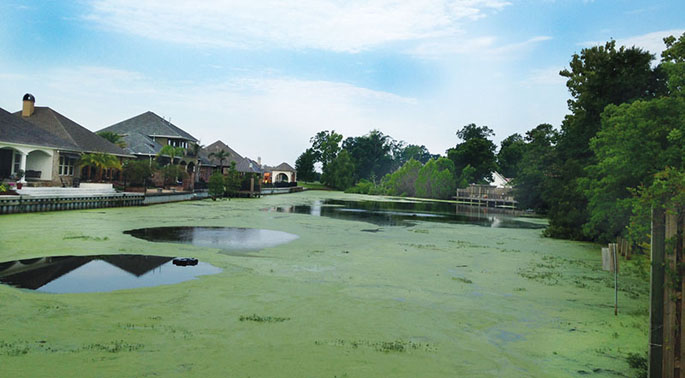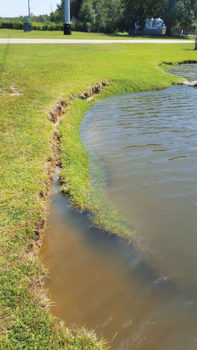
Urban and suburban ponds make up the majority of our treatments and contracts. Many are dressed-up stormwater retention ponds, while some are bona fide lakes in an urban setting with pond management challenges.
I say two things often enough that my co-workers are tired of hearing them. The first is, “I am still learning about ponds and always plan to.” This is not because I am a great scholar; it’s due to the fact that natural waters are incredibly dynamic and complex. Just when you get comfortable, you will be forced to learn something, and ponds will always give you a new scenario or problem to solve.
The second thing I like to say is, “It’s not pond management; it’s people management.” Ponds behave exactly like they should under the right physical conditions, when considering nutrients and biological factors. It’s the people as clients who make the relationship more complicated. Managing potential clients’ expectations that are created from fantasy, the internet and the latest advice from the feed store — that part is complicated.Build Perspective
In most situations, I like to have extended conversations on the phone with potential clients or meet with them at the pond. They may think they are interviewing me, but I am interviewing them as well. Most pond owners need a certain amount of education about their pond and their situation. Not all pond owners will offer the respect you deserve as an experienced biologist, nor will they have a realistic perspective about how business is done.
I try to offer a few talking points to pond owners, especially when they are new and seem open to learning. The unfortunate, yet admirable homeowner’s association (HOA) president generally appreciates them so that he or she can justify a pond budget at the next meeting. Some of the main points include the following:

their knowledge about ponds and setting expectations helps with customer satisfaction.
Water is a focal point and will attract the eye like nothing else in the landscape. That is why so many real estate advertisements use ponds or lakes in photos.
Water is three-dimensional, and it takes effort to affect it. They are usually surprised to find out the actual amount of water circulating in their 2-acre neighborhood pond (326,000 gallons per acre foot is worth remembering to impress a client). This is helpful in explaining why treating vegetation is more expensive, since it also is three-dimensional.
Ponds are man-made and have naturally occurring bad behavior that requires management. Management of a pond needs a budget akin to that which is allocated to the same amount of managed green space, for instance if the 1-acre pond were a 1-acre managed lawn for a park.
Finally, water has an amplified effect on property value for all adjacent properties on and off the pond. Appraisers always look to comparable sales in the area, even the homes on an unmanaged pond that might have sold at a discount.
Budgets

Property that includes a pond or lake is an asset and a liability. Until someone gets a proposal for performing pond work, they don’t know how much money it costs to manage, improve and manipulate an aquatic environment. Last year, an HOA called me to their 6-acre lake. They had not considered management for budgetary reasons, and they also chose to neglect a water hyacinth infestation. They now have a 6-acre raft of water hyacinth. They did not accept my proposal for cleaning it up for budgetary reasons. Another similar hyacinth infestation grew from ½ acre to 3 acres while a neighborhood volunteer attempted to treat it. Then they took the lowest bid, only to be disappointed with the results. At this point, they had already spent their hard-fought budget that stemmed from multiple meetings and a special assessment.
Group Ownership
Many urban ponds are owned by an association or corporate entity. The HOA may control the pond, or in some cases there may be a pond owner’s association, or POA.
A POA is typically made up of homeowners directly adjacent to the pond. They enjoy direct access and may even exclude the other neighbors from accessing the pond for fishing or recreational strolls. However, when a management expense arises, they realize that the number of households splitting the expense is limited. Even without a POA as a subset of an association, many HOA members who are not directly on the pond will frequently object to pond-management budget items. Every HOA member tends to have a different opinion about how to manage the pond, creating numerous challenges for the board of an HOA.

Within a corporate structure, the administrator with a view of the pond from their office will express concern over the perceived condition of the pond. This is typically sent to grounds maintenance, which either tries to address it or contacts an outside pond manager. People and personalities can really come into play here, since pride and poor education can stand in the way as unnecessary challenges to a good solution.
Did the HOA build the pond or lake? No, the developer did. Do they always do it correctly? Absolutely not. Who gets stuck holding the bag? The HOA. Developers often construct ponds with major flaws, either out of ignorance or for the purpose of cutting corners on the budget. This can make for some enormous liabilities, all the while the developer’s real estate agent is selling pond lots at a premium. Typically, when a neighborhood is still being developed, the developer controls decisions. Later, the developer will transfer rights and responsibilities to the HOA. The residents may be excited about their new decision-making power, but they are also assuming ongoing liability, especially when it comes to a pond or lake.
Design Issues to Beware

Long, slender channels that are intended to serve as a feature of the pond are really glorified ditches and rapidly fill with aquatic and terrestrial plants (usually cattails and then willows). Also look out for bad slopes and steep sides on deeper ponds. A nice slope for a pond is 3:1, or 3 feet horizontally for every 1 foot of depth, gently sloping to the edge. This is chiefly for mowing and maintenance considerations. No one, especially commercial landscapers, wants to mow on a sharp hill, especially when your commercial mower can fall in a pond! (Weed-eating isn’t much fun, either.) Also, steep sides on deeply excavated ponds will not remain as a wall of soil and will experience major erosion issues. A predominant wind or lots of wildlife can aggravate this greatly. I have seen homeowners lose 15 feet of their yard into ponds, including sections of fence.
With a lack of forethought or the desire to squeeze in one more premium pond lot, a developer may close off any practical access to the pond. So if I need to treat the pond, the price increases due to the fact that I have to unload the boat and drag it through a 4-foot gate before treating the pond. What if the pond fills in, as many retention ponds do? What if the dam or drainage structure needs work that only a machine can perform? Who wants to volunteer access for an excavator through their yard and fence?
Be careful with water-control structures in general. This includes proper construction and maintenance of dams, as well as proper drain control structures. Water pressure on a dam can be really dangerous for people and property downstream. Trees should not be allowed to grow on a dam, as they can die or be blown over in a storm, causing dam failure. Dams need to be properly constructed and packed with drain-control structures and accommodations for storms depositing large amounts of rain. I recently visited a construction site and the well-constructed dam had a small water-control structure and improper pipe installation. The result was a 20-foot hole in the dam with the sections of pipe deposited in the woods below. Thank goodness there wasn’t a house immediately downstream!
Finally, overfertilization of lawns and landscapes leads to nutrient runoff into retention ponds, which can cause major blooms of algae. Mowing grass and directing grass clippings into the pond provides additional nutrients and physical material to fill the pond. Ducks and geese contribute to erosion and deposit manure in the pond. In fact, 25 resident Canada Geese will produce 13 tons of manure in a year. So think twice before feeding them corn and encouraging them. Pet waste gets washed into the pond, too. Ponds attract and retain litter. Storm drains accumulate it and send it to the pond. Toy balls, ketchup packets, grocery bags, Styrofoam (peanuts, cups, takeout boxes) and cans can all end up in ponds, and we remove them simply because no one else will.
Seeing that we can’t magically fix people and their habits, their general ignorance about ponds will always be a challenge. Just be prepared to educate and navigate people and their perceptions and personalities as you engage in water.


